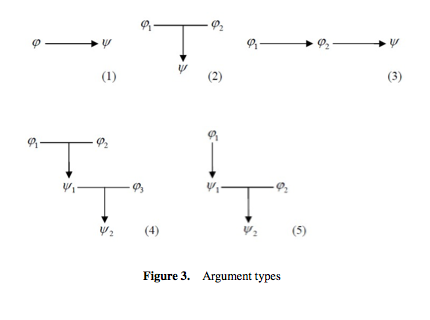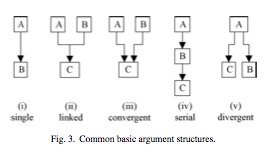Argumentation analysis can be simplified by thinking about the patterns used.
But what are the key patterns? Here are two diagrams showing different views.
Rahwan suggests 5 common basic argument structures: single, linked, convergent, serial, and divergent. ((Iyad Rahwan. Mass argumentation and the Semantic Web. Web Semantics: Science, Services and Agents on the World Wide Web, 6(1):29–37, February 2008. http://dx.doi.org/10.1016/j.websem.2007.11.007))
Meanwhile, Wei and Praken give 5 possible argumentative structures that have one or two inferences. ((Bin Wei and Henry Prakken. Defining the structure of arguments with AI models of argumentation. Computational Models of Natural Argument XII at ECAI 2012. Pages 60-64 in Proceedings.))

From Bin Wei and Henry Prakken. Defining the structure of arguments with AI models of argumentation.
Why 5 structures? Five connected structures emerge from having two types of inference — as unit I (single) and unit II (linked) inference. With two inferences of either type, we can make five patterns: ((Definition 9. The types of arguments can be defined as follows:
(1) An argument A is a unit I argument iff A has the form B ⇒ ψ and subargument B is an atomic argument B : φ. We call the inference rule φ ⇒ ψ a unit I inference.
(2) An argument A is a unit II argument iff A has the form B1,…,Bn ⇒ ψ and subarguments A : B1,…,Bn are atomic arguments B1 : φ1 ,. . . ,Bn : φn . We call the inference rule φ1,…,φn ⇒ ψ a unit II inference.
(3) An argument A is a multiple unit I argument iff all inferences r1, . . . , rn in the argument A are unit I inferences.
(4) An argument A is a multiple unit II argument iff all inferences r1, . . . , rn in the argument A are unit II inferences.
(5) An argument A is a mixed argument iff A has at least one unit I subargument and unit II subargument.
We display the diagrams of argument types in Figure 3. For simplicity, we assume n = 2 in these diagrams and show only one case of a mixed argument.))
(1) unit I argument (single)
(2) unit II argument (linked)
(3) multiple unit I argument (serial)
(4) multiple unit II argument
(5) mixed argument
What is interesting is to look at the differences: Rahwen doesn’t cover (4) multiple unit II and (5) mixed arguments. Meanwhile, Wei and Prakken’s list doesn’t include Rahwen’s convergent & divergent argumentation.
So which are the key patterns?
Single and linked arguments are fundamental, and serial arguments are mathematically simple and Rahwen suggests that they are common in use. ((Statistics on argument use would be valuable, but we have limited information about this. Aracuaria DB? Output from argumentation mining?))But the rest?
Convergent & divergent argumentation structures are both candidates: Wei and Prakken don’t cover these, I suspect, since each could be separated into two separate single arguments, which have the same premise (divergent) or conclusion (convergent). These structures can be important in practice: Convergent arguments give multiple reasons for coming to a conclusion — essential when no single reason suffices. The structure of divergent arguments seems to me to be most useful for showing contradictions in diverse conclusions, e.g. for reductio ad absurdum arguments; I’d love a real-world example of a divergent argument where keeping this structure is important.
